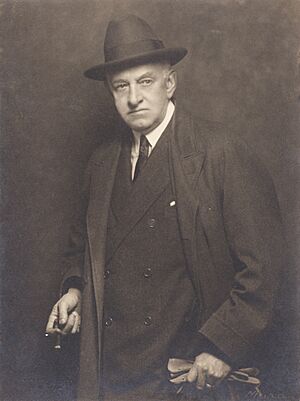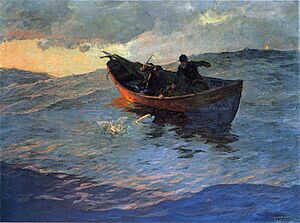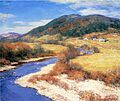Willard Metcalf facts for kids
Quick facts for kids
Willard Metcalf
|
|
|---|---|

Metcalf, c. 1920
|
|
| Born | July 1, 1858 |
| Died | March 9, 1925 (aged 66) |
| Nationality | American |
| Education | School of the Museum of Fine Arts, Boston, Académie Julian, Paris |
| Known for | Painting |
| Movement | Impressionism Landscape art |
| Awards | American Academy of Arts and Letters Inductee |
Willard Leroy Metcalf (July 1, 1858 – March 9, 1925) was a famous American painter. He was born in Lowell, Massachusetts. Metcalf is best known for his beautiful landscape paintings. He often painted scenes of New England.
He studied art at the School of the Museum of Fine Arts, Boston. Later, he went to Académie Julian in Paris, France. Metcalf was part of a group called the Ten American Painters. This group helped shape American Impressionism. He also taught art in New York City.
Contents
Early Life and Art Training
Willard Metcalf started painting in 1874. He opened his own art studio in Boston in 1876. He also received a special scholarship to study at the Boston Museum school. He studied there until 1878.
In 1882, Metcalf had an art show in Boston. The money he earned from selling his paintings helped him travel. He used it to study art in Europe.
European Adventures
Metcalf went to Europe in September 1883. He stayed there for about five years. During this time, he traveled and painted a lot. He studied in Paris with famous artists like Gustave Boulanger.
He also visited England and Brittany, a region in France. In 1884, he met another American painter, John Twachtman, in Paris. Metcalf painted landscapes that showed everyday life, similar to the artist Jean Millet.
By 1886, Metcalf was painting in Giverny, France. He was one of the first American painters to visit this area. Later, he traveled to Algeria and Tunisia in North Africa. He returned to Giverny in the summers of 1887 and 1888. He painted there with other American artists.
Returning to America
Metcalf came back to the United States in 1888. He had a solo art show in Boston. After living in Philadelphia for a short time, he moved to New York in 1890. There, he worked as a portrait painter and teacher.
In 1895, he painted in Gloucester, Massachusetts. He stopped working as an illustrator around this time. In the late 1890s, he did not paint as much. His early contributions to the "Ten American Painters" shows were not very strong.
In 1899, Metcalf helped paint large murals for a New York courthouse. He worked with his friends Robert Reid and Edward Simmons.
A New Artistic Chapter
In 1902, Metcalf traveled to Havana, Cuba. He went there to create studies for a mural. This year, he also painted many important landscapes. These included The Boat Landing and Battery Park-Spring. These paintings showed a new, fresh style and brighter colors.
In 1904, he lived and painted in Clark's Cove, Maine. By 1905, he spent his summers in Old Lyme, Connecticut. His friend Childe Hassam encouraged him to go there. Metcalf worked as both a painter and a teacher in Old Lyme.
He had successful art shows in New York and Boston. His paintings of the New England landscape became very popular. They were praised by art critics and sold well.
May Night and Recognition
In 1907, Metcalf's painting May Night won a gold medal. It also won a top prize of $3,000 from the Corcoran Gallery of Art. This painting was the first modern American artwork bought by that museum. It is now one of Metcalf's most famous works. You can see it at the National Gallery of Art.
The Cornish Art Colony
Metcalf often visited the Cornish Art Colony in Plainfield, New Hampshire and Cornish, New Hampshire. He went there between 1909 and 1921. He often stayed during the quiet winter months. The colony was known for its beautiful hills and views of Mount Ascutney.
In 1909, a playwright named Louis Shipman invited Metcalf to stay at his home. Metcalf returned to Cornish for many winters. He was good friends with artist Charles Platt. Metcalf even spent his honeymoon at Platt's estate in 1911.
Metcalf often painted Blow-me-down Brook, a small creek in the area. He also painted the hills and country buildings. His paintings from Cornish showed the changing seasons. These works helped him become very successful. Critics called him the "poet laureate of the New England hills."
While at the colony, he painted about 35 landscapes. These include Blow-Me-Down (1911) and The White Veil (1909). His painting "Cornish Hills" (1911) is also a beautiful and important work from this time.
Later Years and Legacy
Metcalf continued to have art shows in New York and Boston. In the 1910s, he traveled a lot to find new places to paint. In 1913, he spent nine months painting in Europe. He visited Paris, Norway, England, and Italy.
In the U.S., he painted in Connecticut, Vermont, and Maine. In 1920, he painted Benediction, a night scene. This painting sold for $13,000 in 1923. This was a record price for a painting by a living American artist at that time.
Metcalf continued to paint in Vermont for several years. He may have returned to Cornish briefly.
The Corcoran Gallery of Art held a large show of Metcalf's work in 1925. Metcalf passed away from a heart attack in New York City on March 6, 1925. He was 66 years old.
The Florence Griswold House in Old Lyme, Connecticut, has many of Metcalf's paintings. Many American museums also have his artwork. These include the Metropolitan Museum of Art and the National Gallery of Art. His paintings are also in international collections.
His friend Charles Platt scattered Metcalf's ashes in Cornish, New Hampshire.
Notable Works
- Summer Morning, Giverny (c. 1888)
- Midsummer Twilight (c. 1890, France)
- May Night (1906), painted in Old Lyme, now at the National Gallery of Art
- The White Veil (1909), painted in Plainfield. A second copy, The White Veil (no. 2), is at the Detroit Institute of Arts.
- The Village- September Morning (1911), his only painting of Plainfield Village.
- Benediction (1923), now lost, sold for a record price.
Images for kids
See also
- The Cornish Hills (1911)
- List of Orientalist artists
- Orientalism








